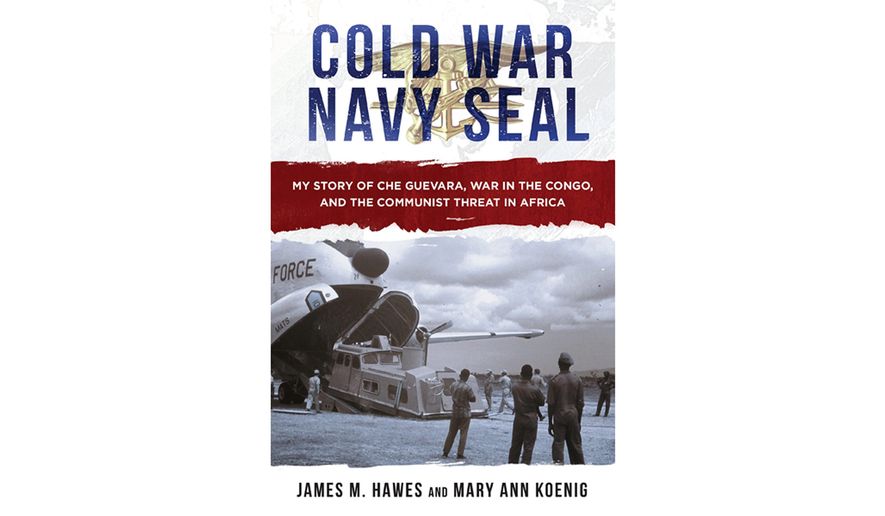OPINION:
COLD WAR NAVY SEAL: MY STORY OF CHE GUEVARA, WAR IN THE CONGO, AND THE COMMUNIST THREAT IN AFRICA
By James M. Hawes and Mary Ann Koenig
Skyhorse Publishing, $22.99, 204 pages
The Cold War, that period following World War II in 1947 until the fall of the Soviet Union in 1991, saw the attempted expansion of communism by the Soviet Union and other communist countries, and the attempted containment of communism by the U.S. and other Western democracies.
As both the U.S. and the Soviet Union had nuclear weapons, all-out war was mostly out of the question, so proxy wars were fought with surrogates backed by the superpowers.
Today, when one thinks of the Cold War, perhaps one thinks of the hot spots of the era, such as Berlin, Korea and Vietnam, but the Cold War was waged nearly all over the world, including Africa.
As former Navy SEAL and CIA operator James W. Hawes notes in his book, “Cold War Navy SEAL: My Story of Che Guevara, War in the Congo, and the Communist Threat in Africa,” Africa was clearly on the Soviet Union and Communist China’s radar in 1965, and the Soviet Union’s client state, Communist Cuba, sent troops and renowned revolutionary Ernesto “Che” Guevara to the Congo to arm and train the Simba Rebels.
The CIA sent a 26-year-old Navy SEAL.
“This is a first-hand, ’names and places’ account of what really happened inside a Cold War CIA program that’s been kept out of the history books. It’s the story of an American Navy SEAL who fought to aid a fledgling democracy in the Congo and stem the tide of communism in Africa,” writes “Cold War Navy SEAL” co-author Mary Ann Koenig in her introduction to the book.
“James M. Hawes built and commanded the Force Navale Congolaise, a clandestine mercenary navy at the very tip of the spear, and was point man for a successful little-known paramilitary operation.”
Ms. Koenig goes on to state that James M. Hawes was a young Navy lieutenant (junior grade) Vietnam veteran without a formal place in the chain of command. He had to interpret situations, adapt and modify plans on the spot, while trying to keep to control a group of brutal and self-serving mercenaries.
“It’s the story of an American naval officer under contract to the CIA who secretly built, staffed, and controlled a clandestine naval enterprise in a war zone in the heart of Africa,” Ms. Koenig writes.
The co-authors tell this mostly unknown chapter in the Cold War using recently declassified documents, interviews with those involved and the memory of Mr. Hawes, as well as Che Guevara’s “Congo Diary,” which Mr. Hawes says validates his recollections of the time.
In “Cold War Navy SEAL” we learn about the early days of the Vietnam War, 1964, when Mr. Hawes, then a SEAL operator with the newly formed SEAL Team Two, became one of the first SEAL officers permanently assigned to the CIA’s OpPlan 34-A, which was a covert operation to train hit-and-run boat teams who ran clandestine raids into North Vietnam.
As Mr. Hawes tells it, those successful raids may have been the reason the North Vietnamese sent out torpedo boats to attack U.S. destroyers in what became known as the Gulf of Tonkin incident.
To create a small boat navy to interdict supplies and weapons on the Congo’s Lake Tanganyika, which was 450 miles long and 45 miles wide, the young frogman had to recruit mercenaries from the 5 Commando Force, which was headed by legendary Col. “Mad” Mike Hoare.
Mr. Hawes recruited Jock Cassidy, Col. Hoare’s sergeant major, a murderous soldier-for-hire, to oversee the mercenaries he had to make sailors of. In an interesting first encounter with the mercenaries, Mr. Hawes used his demolition experience to blow a safe for them.
Mr. Hawes was aided by a small group of anti-Castro Cubans, who were trained and dedicated anti-communists. With swift boats and other small craft, Mr. Hawes’ navy cut off supplies to the brutal Simbas and the Cubans under Che Guevara.
Western intelligence agencies in 1965 had no idea where Guevara was, but they knew he left Cuba and was fomenting revolution somewhere in the world. Mr. Hawes discovered that Guevara was in the Congo when the anti-Castro Cubans heard Cuban voices over the radio.
Mr. Hawes’ navy stopped boats carrying supplies to the Simbas, which, as Guevara notes in his diary, made his revolutionary efforts futile. Mr. Hawes and his navy sent the infamous Guevara and his Communist Cubans packing.
“We had accomplished something unusual, after all,” Mr. Hawes writes. “We built and trained a mercenary navy, crippled the Soviet-backed Simba Rebel supply lines, thwarted Che Guevara and his thugs, and pulled off a successful covert paramilitary op, possibly the only one of its kind before or since.”
“Cold War Navy SEAL” is an interesting and well-written book that reads like a thriller.
• Paul Davis is a writer who covers crime, espionage and terrorism.




Please read our comment policy before commenting.